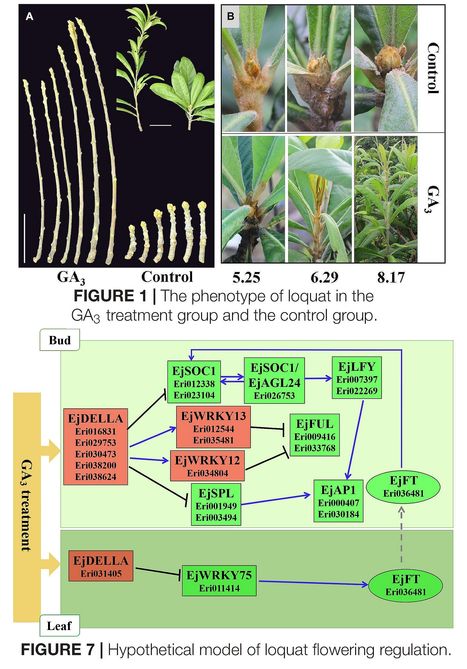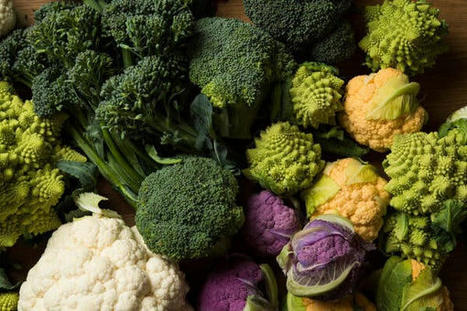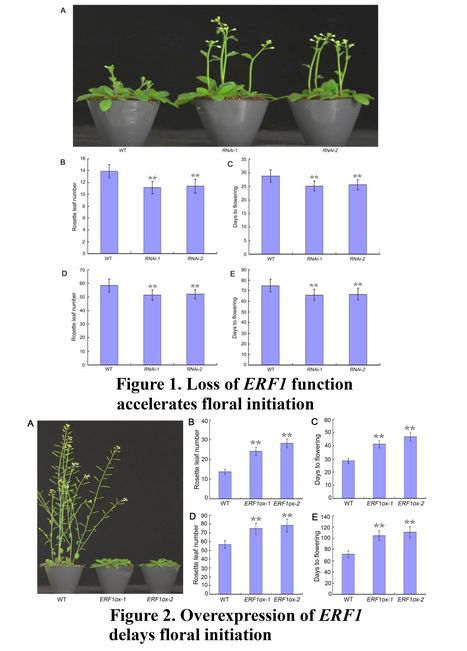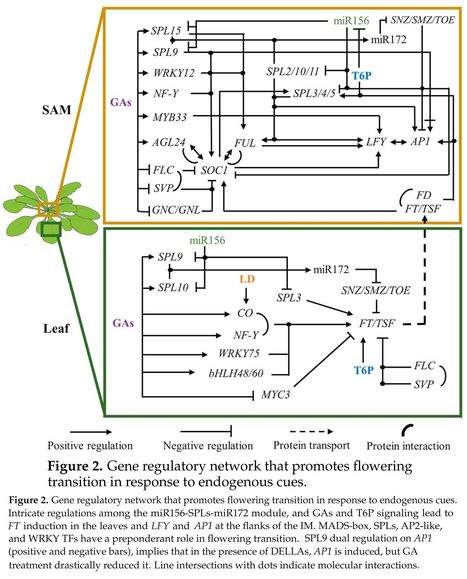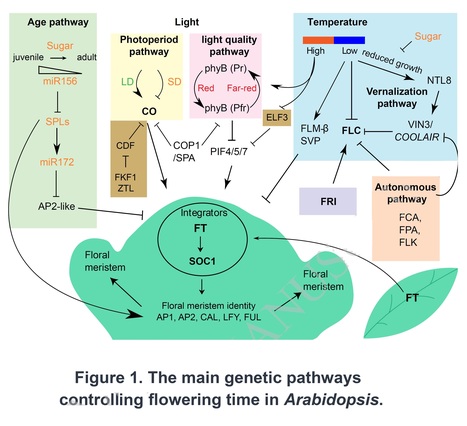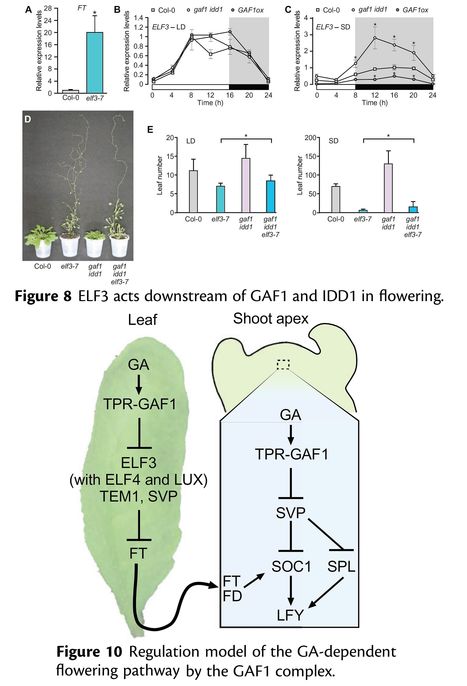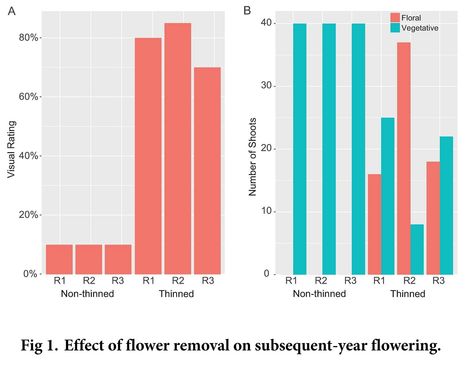 Your new post is loading...
 Your new post is loading...
Authors: Hiroshi Takagi, Nayoung Lee, Andrew K. Hempton, Savita Purushwani, Michitaka Notaguchi, Kota Yamauchi, Kazumasa Shirai, Yaichi Kawakatsu, Susumu Uehara, William G. Albers, Benjamin L. R. Downing, Shogo Ito, Takamasa Suzuki, Takakazu Matsuura, Izumi C. Mori, Nobutaka Mitsuda, Daisuke Kurihara, Tomonao Matsushita, Young Hun Song, Yoshikatsu Sato, Mika Nomoto, Yasuomi Tada, Kousuke Hanada, Josh T. Cuperus, Christine Queitsch and Takato Imaizumi.
bioRxiv (2024)
Abstract: "Seasonal changes in spring induce flowering by expressing the florigen, FLOWERING LOCUS T (FT), in Arabidopsis. FT is expressed in unique phloem companion cells with unknown characteristics. The question of which genes are co-expressed with FT and whether they have roles in flowering remains elusive. Through tissue-specific translatome analysis, we discovered that under long-day conditions with the natural sunlight red/far-red ratio, the FT-producing cells express a gene encoding FPF1-LIKE PROTEIN 1 (FLP1). The master FT regulator, CONSTANS (CO), controls FLP1 expression, suggesting FLP1's involvement in the photoperiod pathway. FLP1 promotes early flowering independently of FT, is active in the shoot apical meristem, and induces the expression of SEPALLATA 3 (SEP3), a key E-class homeotic gene. Unlike FT, FLP1 facilitates inflorescence stem elongation. Our cumulative evidence indicates that FLP1 may act as a mobile signal. Thus, FLP1 orchestrates floral initiation together with FT and promotes inflorescence stem elongation during reproductive transitions."
Authors: Hiroyuki Tsuji and Moeko Sato.
Plant and Cell Physiology (2024)
Abstract: "Plants undergo a series of developmental phases throughout their life-cycle, each characterized by specific processes. Three critical features distinguish these phases: the arrangement of primordia (phyllotaxis), the timing of their differentiation (plastochron) and the characteristics of the lateral organs and axillary meristems. Identifying the unique molecular features of each phase, determining the molecular triggers that cause transitions and understanding the molecular mechanisms underlying these transitions are keys to gleaning a complete understanding of plant development. During the vegetative phase, the shoot apical meristem (SAM) facilitates continuous leaf and stem formation, with leaf development as the hallmark. The transition to the reproductive phase induces significant changes in these processes, driven mainly by the protein FT (FLOWERING LOCUS T) in Arabidopsis and proteins encoded by FT orthologs, which are specified as ‘florigen’. These proteins are synthesized in leaves and transported to the SAM, and act as the primary flowering signal, although its impact varies among species. Within the SAM, florigen integrates with other signals, culminating in developmental changes. This review explores the central question of how florigen induces developmental phase transition in the SAM. Future research may combine phase transition studies, potentially revealing the florigen-induced developmental phase transition in the SAM."
Authors: Akhtar Ali, Shah Zareen, Junghoon Park, Haris Ali Khan, Chae Jin Lim, Zein Eddin Bader, Shah Hussain, Woo Sik Chung, Tsanko Gechev, Jose M Pardo and Dae-Jin Yun.
Journal of Experimental Botany (2024)
Abstract: "The plant hormone abscisic acid (ABA) is an important regulator of plant growth and development and plays a crucial role in both biotic and abiotic stress responses. ABA modulates flowering time but the precise molecular mechanism remains poorly understood. Here we report ABA INSENSITIVE 2 (ABI2), as the only phosphatase from ABA-signaling core that positively regulates the transition to flowering in Arabidopsis. Loss-of-function abi2-2 mutant shows significantly delayed flowering both under long day (LD) and short day (SD) conditions. Expression of floral repressor genes such as FLOWERING LOCUS C (FLC) and CYCLING DOF FACTOR 1 (CDF1) was significantly up-regulated in abi2-2 plants while that of the flowering promoting genes FLOWERING LOCUS T (FT) and SUPPRESSOR OF OVEREXPRESSION OF CONSTANS 1 (SOC1) was down-regulated. Through genetic interactions we further found that ost1-3 and abi5-1 mutations are epistatic to abi2-2, as both of them individually rescued the late flowering phenotype of abi2-2. Interestingly, ABA INSENSITIVE 5 (ABI5) phosphorylation and protein stability were enhanced in abi2-2 plants suggesting that ABI2 dephosphorylates ABI5, thereby reducing protein stability and the capacity to induce FLC expression. Our findings therefore uncovered the unexpected role of ABI2 to promote flowering by inhibiting ABI5-mediated FLC activation in Arabidopsis."
Authors: Xin Zhao, Wenwen Liu, Palinuer Aiwaili, Han Zhang, Yanjie Xu, Zhaoyu Gu, Junping Gao and Bo Hong.
Plant Physiology (2023)
One-sentence summary: Short days accelerate the juvenile-to-adult transition by increasing endogenous gibberellin biosynthesis and perception in chrysanthemum, leading to entry into floral transformation.
Abstract: "The gibberellins (GAs) receptor GA INSENSITIVE DWARF1 (GID1) plays a central role in GA signal perception and transduction. The typical photoperiodic plant chrysanthemum (Chrysanthemum morifolium) only flowers when grown in short-day photoperiods. In addition, chrysanthemum flowering is also controlled by the aging pathway, but whether and how GAs participate in photoperiod- and age-dependent regulation of flowering remain unknown. Here, we demonstrate that photoperiod affects CmGID1B expression in response to GAs and developmental age. Moreover, we identified PHOTOLYASE/BLUE LIGHT RECEPTOR2, an atypical photocleavage synthase, as a CRYPTOCHROME-INTERACTING bHLH1 interactor with which it forms a complex in response to short days to activate CmGID1B transcription. Knocking down CmGID1B raised endogenous bioactive GA contents and GA signal perception, in turn modulating the expression of the aging-related genes MicroRNA156 and SQUAMOSA PROMOTER BINDING PROTEIN-LIKE3. We propose that exposure to short days accelerates the juvenile-to-adult transition by increasing endogenous GA contents and response to GAs, leading to entry into floral transformation."
Authors: Lae-Hyeon Cho, Jinmi Yoon, Win Tun, Gibeom Baek, Xin Peng, Woo-Jong Hong, Izumi C. Mori, Yuko Hojo, Takakazu Matsuura, Sung-Ryul Kim, Sun-Tae Kim, Soon-Wook Kwon, Ki-Hong Jung, Jong-Seong Jeon and Gynheung An.
The Plant Journal (2022)
Abstract: "Increasing the vegetative growth period of crops can increase biomass and grain yield. In rice, the concentration of trans-zeatin, an active cytokinin, was high in the leaves during vegetative growth and decreased rapidly upon induction of florigen expression, suggesting that this hormone is involved in the regulation of the vegetative phase. To elucidate whether exogenous cytokinin application influences the length of the vegetative phase, we applied 6-benzylaminopurine (BAP) to rice plants at various developmental stages. Our treatment delayed flowering time by 8 to 9 d when compared with mock-treated rice plants, but only at the transition stage when the flowering signals were produced. Our observations also showed that flowering in the paddy field is delayed by thidiazuron, a stable chemical that mimics the effects of cytokinin. The transcript levels of florigen genes Heading date 3a (Hd3a) and Rice Flowering locus T1 (RFT1) were significantly reduced by the treatment, but the expression of Early heading date 1 (Ehd1), a gene found directly upstream of the florigen genes, was not altered. In maize, similarly, BAP treatment increased the vegetative phase by inhibiting the expression of ZCN8, an ortholog of Hd3a. We showed that cytokinin treatment induced the expression of two type-A response regulators (OsRR1 and OsRR2) which interacted with Ehd1, a type-B response regulator. We also observed that cytokinin did not affect flowering time in ehd1 knockout mutants. Our study indicated that cytokinin application increases the vegetative phase duration by delaying the expression of florigen genes in rice and maize by inhibiting Ehd1."
Authors: Yuanyuan Jiang, Yicun Liu, Yongshun Gao, Jiangrong Peng, Wenbing Su, Yuan Yuan, Xianghui Yang, Chongbin Zhao, Man Wang, Shunquan Lin, Ze Peng and Fangfang Xie-
Frontiers in Genetics (2021)
Abstract: "Flowering is an integral part of the life cycle of flowering plants, which is essential for plant survival and crop production. Most woody fruit trees such as apples and pears bloom in spring, but loquat blooms in autumn and winter. Gibberellin (GA) plays a key role in the regulation of plant flower formation. In this study, we sprayed loquat plants with exogenous GA3, which resulted in vigorous vegetative growth rather than floral bud formation. We then performed a comprehensive RNA-seq analysis on GA3-treated and control-treated leaves and buds over three time periods to observe the effects of exogenous GA3 application on floral initiation and development. The results showed that 111 differentially expressed genes (DEGs) and 563 DEGs were down-regulated, and 151 DEGs and 506 DEGs were up-regulated in buds and leaves, respectively, upon treatment with GA3. Among those that are homologs of the DELLA-mediated GA signal pathway genes, some may be involved in the positive regulation of flower development, including EjWRKY75, EjFT, EjSOC1, EjAGL24, EjSPL, EjLFY, EjFUL, and EjAP1; while some may be involved in the negative regulation of flower development, including EjDELLA, EjMYC3, EjWRKY12, and EjWRKY13. Finally, by analyzing the co-expression of DEGs and key floral genes EjSOC1s, EjLFYs, EjFULs, EjAP1s, 330 candidate genes that may be involved in the regulation of loquat flowering were screened. These genes belong to 74 gene families, including Cyclin_C, Histone, Kinesin, Lipase_GDSL, MYB, P450, Pkinase, Tubulin, and ZF-HD_dimer gene families. These findings provide new insights into the regulation mechanism of loquat flowering."
Authors: Yvon Jaillais and François Parcy
Science (2021)
Excerpts: "Although conserved throughout flowering plants, the function of FT lipid-binding capacity has remained enigmatic. On page 1137 of this issue, Susila et al. (3) show that FT binds to the anionic phospholipid phosphatidylglycerol, which sequesters FT in membrane compartments of phloem cells at low temperature, thereby delaying flowering in cold conditions. Thus, a temperature-dependent regulation of FT translocation by a membrane phospholipid tunes the plant response to ambient temperature. Susila et al. found that FT binds to the anionic phospholipid phosphatidylglycerol in vitro and in phloem cells in vivo."
"Susila et al. found that in A. thaliana protoplasts (plant cells without a cell wall), FT associates with various membranes that contain phosphatidylglycerol: the plasma membrane, Golgi apparatus, trans-Golgi network, endoplasmic reticulum, and chloroplast envelope. Low temperature (i.e., a long day at 16°C) induced the interaction between FT and cellular membranes in a phosphatidylglycerol-dependent manner."
"Low temperature promotes the phosphatidylglycerol-dependent retention of FT in cellular membranes of companion cells, which delays flowering by reducing FT movement toward the sieve elements and thus the shoot meristem. In phosphatidylglycerol biosynthetic mutants, this temperature-dependent retention is reduced, leading to an early flowering phenotype and temperature insensitivity. During long days at 23°C, FT is not sequestered within companion cell membranes and moves into phloem sieve elements to reach the shoot apical meristem and accelerate flowering."
Authors: D. S. Gorshkova, I. A. Getman, L. I. Sergeeva, Vl. V. Kuznetsov and E. S. Pojidaeva.
Doklady Biochemistry and Biophysics (2021)
Abstract: "The effect of T-DNA insertion in the 3'-UTR region of Arabidopsis thaliana At3g58450 gene encoding the Germination-Related Universal Stress Protein (GRUSP) was studied. It was found that under a long-day condition this mutation delays transition to flowering of grusp-115 transgenic line that due to a reduced content of endogenous bioactive gibberellins GA1 and GA3 in comparison to the wild-type plants (Col-0). Exogenous GA accelerated flowering of both lines but did not change the time of difference in the onset of flowering between Col-0 and grusp-115. In addition to changes in GA metabolism, grusp-115 evidently has disturbances in realization of the signal that induces flowering. This is confirmed by the results of gene expression of the floral integrator FLOWERING LOCUS T (FT) and the floral repressor FLOWERING LOCUS C (FLC), which are key flowering regulators and acting opposite. We hypothesize that the formation of grusp-115 phenotype can also be affected by a low expression level of FT due to up-regulated FLC expression."
Author: Sabrine Imbler
The New York Times
One-sentence summary: "Scientists take a crack at recreating the hypnotic fractal spirals of the Romanesco cauliflower."
Via Herman Höfte
Authors: Yanli Chen, Liping Zhang, Haiyan Zhang, Ligang Chen and Diqiu Yu.
Journal of Integrative Plant Biology (2021)
Abstract: "ETHYLENE RESPONSE FACTOR1 (ERF1) is a key component in ethylene signaling, playing crucial roles in both biotic and abiotic stress responses. Here, we demonstrate that ERF1 also has an important role during floral initiation in Arabidopsis thaliana. Knockdown or knockout of ERF1 accelerated floral initiation, whereas overexpression of ERF1 dramatically delayed floral transition. These contrasting phenotypes were correlated with opposite transcript levels of FLOWERING LOCUS T (FT). Chromatin immunoprecipitation assays revealed that ERF1 associates with genomic regions of the FT gene to repress its transcription. ft-10/ERF1RNAi plants showed a similar flowering phenotype to the ft-10 mutant, whereas the flowering of FTox/ERF1ox mimicked that of FTox plants, suggesting that ERF1 acts upstream of FT during floral initiation. Similarly, altered floral transition in ethylene-related mutants was also correlated with FT expression. Further analysis suggested that ERF1 also participates in delay in flowering-time control mediated by the ethylene precursor 1-aminocyclopropane-1-carboxylic acid. Thus, ERF1 may act as a negative modulator of flowering-time control by repressing FT transcription in Arabidopsis."
Authors: Stella Quiroz, Juan Carlos Yustis, Elva C. Chávez-Hernández, Tania Martínez, Maria de la Paz Sanchez, Adriana Garay-Arroyo, Elena R. Álvarez-Buylla and Berenice García-Ponce.
International Journal of Molecular Sciences (2021)
Abstract: "Flowering is one of the most critical developmental transitions in plants’ life. The irreversible change from the vegetative to the reproductive stage is strictly controlled to ensure the progeny’s success. In Arabidopsis thaliana, seven flowering genetic pathways have been described under specific growth conditions. However, the evidence condensed here suggest that these pathways are tightly interconnected in a complex multilevel regulatory network. In this review, we pursue an integrative approach emphasizing the molecular interactions among the flowering regulatory network components. We also consider that the same regulatory network prevents or induces flowering phase change in response to internal cues modulated by environmental signals. In this sense, we describe how during the vegetative phase of development it is essential to prevent the expression of flowering promoting genes until they are required. Then, we mention flowering regulation under suboptimal growing temperatures, such as those in autumn and winter. We next expose the requirement of endogenous signals in flowering, and finally, the acceleration of this transition by long-day photoperiod and temperature rise signals allowing A. thaliana to bloom in spring and summer seasons. With this approach, we aim to provide an initial systemic view to help the reader integrate this complex developmental process."
Authors: Tom Bennett.
The Biochemist (2021)
Abstract: "The development of hormonal contraceptives stands out as a key contribution of biochemistry to the 20th century, part of the wider ‘sexual revolution’ that dramatically changed society in many Western countries. But unbeknown to them, the pioneers of the contraceptive pill had been beaten to the idea by a few hundred million years, by a rather unlikely group of organisms that have been using hormones as contraceptives since their own sexual revolutions back in the swinging Palaeozoic. Since their successful conquest of land in the Ordovician, land plants had been restricted in the genetic mixing and expansion of populations by their relative immobility. A series of key innovations in the seed plant group, and in particular in flowering plants, enabled plants to mate and to disperse their offspring over much longer distances, by harnessing the wind or animals to provide mobility. However, all this ‘outsourcing’ created new challenges; coordinating and optimizing reproductive effort is not straightforward when it depends on a third party. Here, I discuss some of the key signalling molecules – sex hormones, as it were – that plants use to plan their families and manage their fertility, and why this matters to us, now more than ever."
Authors: Charity Goeckeritz and Courtney A. Hollender.
Current Opinion in Plant Biology (2021)
Abstract: "The regulation of bloom time in deciduous fruit trees is an area of increasing interest due to the negative impact of climate change on fruit production. Although flower development has been well-studied in model species, there are many knowledge gaps about this process in perennial fruit trees, whose floral development spans the four seasons and includes many temperature-driven transitions. To develop solutions for minimizing crop loss, a comprehensive research strategy is needed to understand flower development and bloom time in deciduous fruit trees. This approach must incorporate genetic, physiological, and phenological strategies which include morphological and molecular analyses. Here, we describe key floral development events for rosaceae family fruit trees, highlight recent molecular and genetic discoveries, and discuss future directions for this field."
|
Authors: Ping Huang, Jie Yang, Jiapeng Ke, Li Cai, Yingxiong Hu, Jun Ni, Chaoqiong Li, Zeng-Fu Xu and Mingyong Tang.
Plant Science (2024)
Highlights • GA4+7 and GA synthase gene JcGA20ox1 suppressed flowering in Jatropha, whereas the GA biosynthesis inhibitor paclobutrazol and GA degradation gene JcGA2ox6 promoted flowering. • JcGA20ox1 decreased the expression of JcFT; while, the inhibition of floral transition by JcGA20ox1 could restored by JcFT, and the seed yield suppression phenotype could partially restored by JcFT. • JcGA20ox1 also decreased JiFT expression and delayed floral transition in J. curcas × J. integerrima hybrids.
Abstract: "Jatropha curcas is a perennial oil-seed plant with vigorous vegetative growth but relatively poor reproductive growth and low seed yield. Gibberellins (GA) promote flowering in most annual plants, but inhibit flower initiation in many woody plants, including J. curcas. However, the underlying mechanisms of GA inhibition on flowering in perennial woody plants remain unclear. Here, we found that overexpression of the gibberellin biosynthesis gene JcGA20ox1 delays flowering in J. curcas and in the J. curcas × J. integerrima hybrids. Consistent with this finding, overexpression of the GA catabolic gene JcGA2ox6 induces early flowering in J. curcas. qRTsingle bondPCR revealed that the inhibition of floral transition by overexpressing JcGA20ox1 resulted from the decreased of JcFT and other flowering related genes, which was restored by overexpressing JcFT in J. curcas. Overexpression of JcGA20ox1 or JcGA2ox6 reduced seed yield, but overexpression of JcFT significantly increased seed yield. Furthermore, hybridization experiments showed that the reduction in seed yield caused by overexpression of JcGA20ox1 or JcGA2ox6 was partially restored by the overexpression of JcFT. In addition, JcGA20ox1, JcGA2ox6 and JcFT were also found to be involved in the regulation of seed oil content and endosperm development. In conclusion, our study revealed the inhibitory effect of GA on flowering in J. curcas is mediated through JcFT and demonstrated the effects of JcGA20ox1, JcGA2ox6 and JcFT on agronomic traits. This study also indicates the potential value of GA metabolism genes and JcFT in breeding new varieties of woody oil-seed plants."
Authors: Robert Maple, Pan Zhu, Jo Hepworth, Jia-Wei Wang and Caroline Dean.
Plant Physiology (2024)
Abstract: "Plant species have evolved different requirements for environmental/endogenous cues to induce flowering. Originally, these varying requirements were thought to reflect the action of different molecular mechanisms. Thinking changed when genetic and molecular analysis in Arabidopsis thaliana revealed that a network of environmental and endogenous signalling input pathways converge to regulate a common set of ‘floral pathway integrators’. Variation in the predominance of the different input pathways within a network can generate the diversity of requirements observed in different species. Many genes identified by flowering time mutants were found to encode general developmental and gene regulators, with their targets having a specific flowering function. Studies of natural variation in flowering were more successful at identifying genes acting as nodes in the network central to adaptation and domestication. Attention has now turned to mechanistic dissection of flowering time gene function and how that has changed during adaptation. This will inform breeding strategies for climate-proof crops and help define which genes act as critical flowering nodes in many other species."
Authors: Yongyu Huang, Andreas Maurer, Ricardo F. H. Giehl, Shuangshuang Zhao, Guy Golan, Venkatasubbu Thirulogachandar, Guoliang Li, Yusheng Zhao, Corinna Trautewig, Axel Himmelbach, Andreas Börner, Murukarthick Jayakodi, Nils Stein, Martin Mascher, Klaus Pillen and Thorsten Schnurbusch.
Molecular Biology and Evolution (2024)
Abstract: "Vascular plants have segmented body axes with iterative nodes and internodes. Appropriate node initiation and internode elongation are fundamental to plant fitness and crop yield; however, how these events are spatiotemporally coordinated remains elusive. We show that in barley (Hordeum vulgare L.), selections during domestication have extended the apical meristematic phase to promote node initiation, but constrained subsequent internode elongation. In both vegetative and reproductive phases, internode elongation displays a dynamic proximal – distal gradient, and among subpopulations of domesticated barleys worldwide, node initiation and proximal internode elongation are associated with latitudinal and longitudinal gradients, respectively. Genetic and functional analyses suggest that, in addition to their converging roles in node initiation, flowering-time genes have been repurposed to specify the timing and duration of internode elongation. Our study provides an integrated view of barley node initiation and internode elongation, and suggests that plant architecture should be recognized as a collection of dynamic phytomeric units in the context of crop adaptive evolution."
Authors: M. Agustí, C. Reig, A. Martínez-Fuentes and C. Mesejo.
Frontiers in Plant Science (2022)
Abstract: "Citrus are polycarpic and evergreen species that flower once in spring or several times a year depending on the genotype and the climatic conditions. Floral induction is triggered by low temperature and water-deficit stress and occurs 2–3 months before bud sprouting, whereas differentiation takes place at the same time as sprouting. The induced buds develop single flowers or determinate inflorescences, so that vegetative growth is required at the axillary buds to renew the polycarpic habit. The presence of fruits inhibits sprouting and flower induction from nearby axillary buds in the current season. In some species and cultivars, this results in low flowering intensity the following spring, thus giving rise to alternate bearing. A number of key flowering genes act in the leaf (CiFT3, CcMADS19, etc.) or in the bud (CsLFY, CsTFL1, etc.) to promote or inhibit both flowering time and reproductive meristem identity in response to these climatic factors, the fruit dominance, or the age of the plant (juvenility). The expression of some of these genes can be modified by gibberellin treatments, which reduce bud sprouting and flowering in adult trees, and constitute the main horticultural technique to control flowering in citrus. This review presents a comprehensive view of all aspects of the flowering process in citrus, converging the research published during the past half century, which focused on plant growth regulators and the nutritional source-sink relationships and guided research toward the study of gene transcription and plant transformation, and the advances made with the development of the tools of molecular biology published during the current century."
Authors: Prasanta K. Dash and Rhitu Rai.
Journal of Biotechnology (2021)
Highlights: • Hormonal Control of Important Agronomic Traits has been intense field of research that gave rise to green revolution in rice and wheat. Recently, the new plant hormone florigen has shown to increase the yield of crops in a dramatic way breaking the yield plateau in vegetable crop tomato. • Here, we highlight the role of green revolution that averted the imminent world hunger in 1960s and intrinsic role of plant hormones in impacting success of green revolution. The role of Gibberellins, auxin, cytokinins and cytokinin oxidase (CKX) in revolutionizing grain yield has been discussed. • An update on the newly discovered phytohormone "Florigen" and its impact on revolutionizing yield in tomato has been discussed. • We chart out a path for tinkering the plant hormones for future use to feed the ever increasing world population.
Abstract: "Burgeoning human population dents, globally, the brimming buffer stock as well as gain in food grain production. An imminent global starvation was averted through precise scientific intervention and pragmatic policy changes in the 1960s and was eulogized as the “Green Revolution”. Miracle rice and wheat obtained through morphometric changes in the ideotype of these two crops yielded bumper harvest that nucleated in Asia and translated into Latin America. The altered agronomic traits in these two crops were the result of the tinkering of the phyto-hormone “Gibberellin’. Recently, another plant hormone ‘Cytokinin’ has gained prominence for its involvement in the grain revolution in rice and other field crops. Suo moto homeostasis of CK by the cytokinin oxidase enzyme governs the cardinal shoot apical meristem that produces new flowering primordia thereby enhances grain number. Similarly, the flowering hormone ‘Florigen’ impacts sympodia formation, flowering, and fruit production in tomato. The role of heterozigosity induced heterosis by florigen in revolutionizing tomato production and cellular homeostasis of CK by CK oxidising enzyme (CKX) in enhancing rice production has been path-breaking. This review highlights role of phytohormones in grain revolution and crop specific fine-tuning of gibberellins, cytokinins and florigen to accomplish maximum yield potential in field crops."
Authors: Fengying Chen, Yu Li, Xiaoying Li, Wenlong Li, Jimei Xu, Hong Cao, Zhi Wang, Yong Li, Wim J.J. Soppe and Yongxiu Liu.
The Plant Journal (2021)
Abstract: "Ectopic expression of specific genes in seeds could be a tool for molecular design of crops to alter seed dormancy and germination, thereby improving production. Here, a seed-specific vector, 12S-pLEELA, was applied to study the roles of genes in Arabidopsis seeds. Transgenic lines containing FLOWERING LOCUS T (FT) driven by the 12S promoter exhibited significantly increased seed dormancy and earlier flowering. Mutated FT(Y85H) and TERMINAL FLOWER1 (TFL1) transgenic lines also showed increased seed dormancy but without altered flowering time. FT(Y85H) and TFL1 caused weaker seed dormancy enhancement compared to FT. The FT and TFL1 transgenic lines showed hypersensitivity to paclobutrazol, but not to abscisic acid in seed germination. The levels of bioactive gibberellin 3 (GA3) and GA4 were significantly reduced, consistent with decreased expression of COPALYL DIPHOSPHATE SYNTHASE (CPS), KAURENE OXIDASE (KO), GIBBERELLIN 3-OXIDASE2 (GA3ox2), and GA20ox1 in p12S::FT lines. Exogenous GA4+7 could recover the germination ability of FT transgenic lines. These results revealed that FT regulates GA biosynthesis. A genetic analysis indicated that the GA signaling regulator SPINDLY (SPY) is epistatic to FT in GA-mediated seed germination. Furthermore, DELAY OF GERMINATION1 (DOG1) showed significantly higher transcript levels in p12S::FT lines. Seed dormancy analysis of dog1-2 spy-3 p12S::FT-2 indicated that the combination of SPY and DOG1 is epistatic to FT in the regulation of dormancy. Overall, we showed that ectopic expression of FT and TFL1 in seeds enhances dormancy through affecting GA and DOG1 pathways."
Authors: Hendry Susila, Snježana Jurić, Lu Liu, Katarzyna Gawarecka, Kyung Sook Chung, Suhyun Jin, Soo-Jin Kim, Zeeshan Nasim, Geummin Youn, Mi Chung Suh, Hao Yu and Ji Hoon Ahn.
Science (2021)
Editor's view: Linking flowering to ambient temperature In the small mustard plant Arabidopsis, the florigen FLOWERING LOCUS T (FT) mobilizes to initiate flowering at the shoot apical meristem. Susila et al. now show that FT, which is produced in leaf cells, can be held in reserve if ambient temperatures are not favorable (see the Perspective by Jaillais and Parcy). At low temperatures, FT binds a membrane phosopholipid and is thus restricted in mobility. At higher temperatures, such binding is less favored, and FT is released to mobilize into the shoot apical meristem to drive flowering. Thus, temperature-sensitive lipid binding helps the plant time flowering with favorable ambient temperatures.
Abstract: "Plants respond to temperature changes by modulating florigen activity to optimize the timing of flowering. We show that the Arabidopsis thaliana mobile florigen FLOWERING LOCUS T (FT) interacts with the negatively charged phospholipid phosphatidylglycerol (PG) at cellular membranes and binds the lipid bilayer. Perturbing PG biosynthesis in phloem companion cells leads to temperature-insensitive early flowering. Low temperatures facilitate FT sequestration in the cellular membrane of the companion cell, thus reducing soluble FT levels and delaying flowering. A mutant in PHOSPHATIDYLGLYCEROLPHOSPHATE SYNTHASE 1 accumulates more soluble FT at lower temperatures and exhibits reduced temperature sensitivity. Thus, cellular membranes sequester FT through their ability to bind the phospholipid PG, and this sequestration modulates the plant’s response to temperature changes."
Authors: A. Kumar, A. Choudhary, N. Kaur and H. Kaur.
Russian Journal of Plant Physiology (2021)
Abstract: "The transition from vegetative to floral buds is a complex phenomenon regulated by many factors. The timing of floral transduction has a direct impact on the reproductive success and is influenced by physiological signals mediated endogenously as well as exogenously. Flowering is the first step of sexual reproduction, so it is important to find out the factors that regulate the signals during the transition phase. The instance of floral evocation has started an unstoppable cascade on the path of reproductive success which can be regulated by sensible signals. The receptivity and inductive signals essential for flowering vary in plant species, and, create a line of differentiation, although basic calls are conserved. The transition progression in plants for blooming under diverse environmental facilities provokes the identity to force the change from vegetative to reproductive phase. Winter memory, light flakes, endogenous hormonal cycling, nutrient status, and contiguous environments are all the factors which set the center stage for flowering. Flowering is well-established by approaches which work in a combinatorial manner and, ensure a cushion for the plant to create a miniature for future. In this review, we provide a detailed outlook on fundamental cues instigating blooming: where, how and when the flowering signals are created."
Authors: Eugenio Azpeitia, Gabrielle Tichtinsky, Marie Le Masson, Antonio Serrano-Mislata, Jérémy Lucas, Veronica Gregis, Carlos Gimenez, Nathanaël Prunet, Etienne Farcot, Martin M. Kater, Desmond Bradley, Francisco Madueño, Christophe Godin and François Parcy.
Science (2021)
Editor's view: Vegetal fractals Cauliflower, along with dahlias and daisies, develop as phyllotactic spirals. Azpeitia et al. combined modeling with experimental investigation to clarify the gene-regulatory network that sets up a multitude of undeveloped flowers to form a cauliflower curd. Irrepressible inflorescence identity genes in the context of dysfunctional meristems and slow internode elongation result in piles of incomplete flowers. If meristem size drifts during organogenesis, then the conical structures of the Romanesco form emerge in fractal formation.
Abstract: "Throughout development, plant meristems regularly produce organs in defined spiral, opposite, or whorl patterns. Cauliflowers present an unusual organ arrangement with a multitude of spirals nested over a wide range of scales. How such a fractal, self-similar organization emerges from developmental mechanisms has remained elusive. Combining experimental analyses in an Arabidopsis thaliana cauliflower-like mutant with modeling, we found that curd self-similarity arises because the meristems fail to form flowers but keep the “memory” of their transient passage in a floral state. Additional mutations affecting meristem growth can induce the production of conical structures reminiscent of the conspicuous fractal Romanesco shape. This study reveals how fractal-like forms may emerge from the combination of key, defined perturbations of floral developmental programs and growth dynamics."
Authors: Wenjun Chen, Huaqing Li, Dongmei Zou, Youquan Yuan, Chaochao Li, Aijia Yang, Zhihong Zhang and Yuexue Liu.
Journal of Plant Growth Regulation (2021)
Abstract: "FT homologs are crucial for the flowering process, playing a vital role as ‘florigens’ in plants. In this study, we isolated and characterized an FT homolog, FaFT1, from cultivated strawberry. Nucleotide sequence analysis revealed a 531-bp open reading frame in FaFT1, encoding a putative protein with typical DPDxP and GxHR motifs belonging to the PEBP family proteins. For vegetative tissues or organs, qRT-PCR revealed that FaFT1 was primarily expressed in leaves. Notably high expression levels were detected in flowers and fruits, including the pith and cortex of the receptacle. Analysis of potential putative cis-acting regulatory elements (CREs) in this gene promoter indicated that many of them are associated with plant hormonal responses and abiotic stress responses. Expression detection confirmed that GA3 treatment enhanced the expression of FaFT1. When ectopically expressed in Arabidopsis, FaFT1 could promote the flowering process under SD conditions. These results suggested the possible role of FaFT1 in the regulation of reproductive development in cultivated strawberry."
Authors: Jutarou Fukazawa, Yuki Ohashi, Ryuhei Takahashi, Kanako Nakai and Yohsuke Takahashi.
The Plant Cell (2021)
Abstract: "Flowering is the developmental transition from the vegetative to the reproductive phase. FLOWERING LOCUS T (FT), SUPPRESSOR OF OVEREXPRESSION OF CONSTANS1 (SOC1), and LEAFY (LFY) are floral integrators. These genes are repressed by several floral repressors including EARLY FLOWERING3 (ELF3), SHORT VEGETATIVE PHASE (SVP), TEMPRANILLO1 (TEM1), and TEM2. Although gibberellin (GA) promotes flowering by activating the floral integrator genes, the exact molecular mechanism remains unclear. DELLAs are negative regulators in GA signaling and act as coactivators of the transcription factor GAI ASSOCIATED FACTOR 1 (GAF1). GAs convert the GAF1 complex from a transcriptional activator to a repressor. Here, we show that GAF1 functions in the GA-dependent flowering pathway by regulating FT and SOC1 expression in Arabidopsis thaliana. We identified four flowering repressors, ELF3, SVP, TEM1, and TEM2, as GAF1-target genes. In response to GAs, GAF1 forms a transcriptional repressor complex and promotes the expression of FT and SOC1 through the repression of four flowering repressor genes, ELF3, SVP, TEM1, and TEM2."
Authors: Chris Gottschalk, Songwen Zhang, Phil Schwallier, Sean Rogers, Martin J. Bukovac and Steve van Nocker.
PLoS ONE (2021)
Abstract: "Many apple cultivars are subject to biennial fluctuations in flowering and fruiting. It is believed that this phenomenon is caused by a repressive effect of developing fruit on the initiation of flowers in the apex of proximal bourse shoots. However, the genetic pathways of floral initiation are incompletely described in apple, and the biological nature of floral repression by fruit is currently unknown. In this study, we characterized the transcriptional landscape of bourse shoot apices in the biennial cultivar, ’Honeycrisp’, during the period of floral initiation, in trees bearing a high fruit load and in trees without fruit. Trees with high fruit load produced almost exclusively vegetative growth in the subsequent year, whereas the trees without fruit produced flowers on the majority of the potential flowering nodes. Using RNA-based sequence data, we documented gene expression at high resolution, identifying >11,000 transcripts that had not been previously annotated, and characterized expression profiles associated with vegetative growth and flowering. We also conducted a census of genes related to known flowering genes, organized the phylogenetic and syntenic relationships of these genes, and compared expression among homeologs. Several genes closely related to AP1, FT, FUL, LFY, and SPLs were more strongly expressed in apices from non-bearing, floral-determined trees, consistent with their presumed floral-promotive roles. In contrast, a homolog of TFL1 exhibited strong and persistent up-regulation only in apices from bearing, vegetative-determined trees, suggesting a role in floral repression. Additionally, we identified four GIBBERELLIC ACID (GA) 2 OXIDASE genes that were expressed to relatively high levels in apices from bearing trees. These results define the flowering-related transcriptional landscape in apple, and strongly support previous studies implicating both gibberellins and TFL1 as key components in repression of flowering by fruit."
|



 Your new post is loading...
Your new post is loading...





